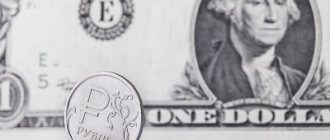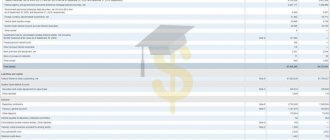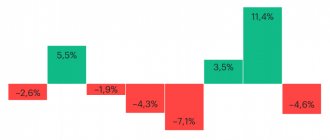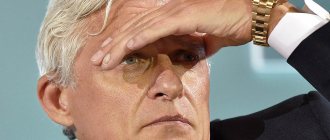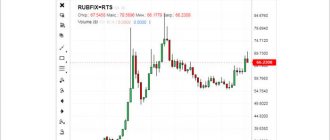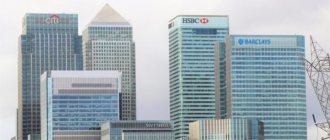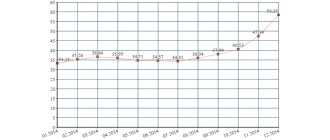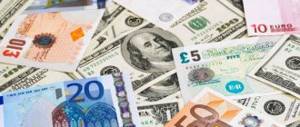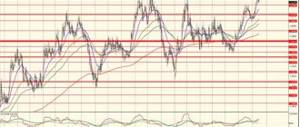Russian ruble (₽, RUB) is in 17th position among the most traded currency pairs in the world (1.1% of daily transactions). Here it competes with the Indian rupee, which also has 1.1% of daily transactions. It is the second most popular currency (after the USD RUB pair) among Russian Forex traders. The EUR/RUB ratio shows the price of the euro in Russian rubles. So, the price of 73.06 for June 2021, for the EUR RUB pair, shows that today 1 euro costs 73 rubles 6 kopecks.
What does the EUR RUB exchange rate depend on?
The exchange rate of the Russian ruble against the euro ( EURRUB) depends on changes in the EUR index and ... on the policies of the Central Bank of Russia, including periodic foreign exchange interventions to adjust the ruble exchange rate against the euro.
Thus, if
- If a bullish trend is formed in the EUR index, then in the EUR RUB currency pair there will also be a bullish movement aimed at reducing the ruble exchange rate against the euro, and vice versa, if the euro exchange rate decreases, a bearish trend in the ruble will be observed (the ruble will strengthen against the euro);
- When the Central Bank of the Russian Federation intervenes, the ruble exchange rate against the euro either strengthens or its decline slows down.
Compare
two charts of the EUR index and the EUR RUB currency pair. Periods of trends are identified for the euro indices and the euro-ruble pair.
Example: in October 2014, the Central Bank of the Russian Federation sold 27 billion dollars and 1.6 billion euros in order to stop the depreciation of the ruble. As you can see, after 3 days the decline resumed and continued for another 2 months.
The analyst calculated when the ruble will skyrocket
MOSCOW, May 19 — PRIME. The ruble exchange rate will be able to strengthen to 2021 values closer to the end of this year or by the beginning of 2022, if the coronavirus is defeated, and it is the raw materials component in the Russian currency that will give that same explosive growth. However, we should not forget about geopolitics and complex relations with Europe and the United States, which are still Russia’s most important trading partners. A worsening of the already difficult situation could lead to another round of weakening of the Russian currency, Andrei Maslov, an analyst at FINAM Group, told the Prime agency.
The financier told how to work less and earn more
“Talks about returning the ruble to its previous historical levels have been going on since 2014 and occur every time the ruble exchange rate breaks through another resistance level,” he notes. In general, according to him, the Russian currency has become somewhat of an outsider among other currencies of developing countries due to the increase in the geopolitical component of the ruble.
“You can remember how the ruble collapsed against the background of the presidential race in the United States last fall or at the beginning of the coronavirus pandemic in the world in the spring. Of course, like other currencies of developing countries, the Russian ruble is a risky asset, and what negatively affects global stability also negatively affects the ruble,” the analyst adds.
However, even among BRICS colleagues, the ruble turned out to be more vulnerable, which is largely due to the information background around Russia, which fuels that very uncertainty, making the Russian ruble a “currency of fear” among investors.
Continuing the conversation about political factors, the expert notes that the most important of them remains the confrontation with the United States and Western countries, which in practice was shown by the recent fall of the ruble due to tensions on the border with Ukraine and Russian army exercises in the south and Crimea.
Russians were warned about an unusual deception at the supermarket checkout
The sanctions pressure on Russia had a rather limited impact on the national currency. As recently introduced sanctions by the United States have shown, they are unlikely to be able to critically weaken the ruble. Risk factors remain the likely disconnection of Russia from SWIFT and the restriction of investments in secondary Russian government debt.
“Here it is worth understanding that the share of non-residents in Russian government debt has been declining for several years and is already less than 30%, and disconnection from SWIFT will harm both Russian banks working with foreign clients, and vice versa, and in general will simply complicate trivial procedures,” - Maslov points out.
As for the second important component - energy resources, here the Russian currency generally behaves similarly to other resource-dependent currencies, reacting quite adequately to price fluctuations. The latter depend on a decline in demand in India and Latin America, where the COVID-19 pandemic is currently raging.
How to understand that the dollar collapse has already begun
“The recovery in demand for “black gold” may accelerate closer to the beginning of the heating season at the end of the third - beginning of the fourth quarter of this year, if another mutated strain of the virus does not force the governments of individual countries to introduce states of emergency and lockdowns,” the expert concluded.
Which indicators are best suited for analyzing and forecasting the EUR RUB exchange rate?
The EUR RUB exchange rate, like other currency pairs, such as USD RUB, GBP USD, USD CHF or AUD USD, moves according to MF levels - the levels of accumulations of market maker orders. Such levels are given daily on the closed forum of the Masterforex-V Academy.
Along with the MF levels, Academy traders use proprietary indicators developed at the Masterforex-V Academy: these are AO_Zotik (instead of the classic Bill Williams AO) and WPR_VSMARK.
The chart shows only 4 instruments out of more than 30 that are taught at the Masterforex-V Academy, but you can already see how much easier it has become to understand every movement of a currency pair in the Forex market.
Analysts gave a forecast for the dynamics of the ruble and stock exchanges for the week
MOSCOW, May 21 — PRIME. Analysts at investment companies and banks expect growth in the Russian stock market next week according to the main indices and contradictory but insignificant dynamics of the ruble against the main reserve currencies, according to a survey conducted by RIA Novosti.
In accordance with the consensus forecast, compiled on the basis of analysts' expectations, the Moscow Exchange and RTS indices will increase over the week by 0.4%, to 3674 points, and by 0.6%, to 1580 points, respectively, experts expect.
The price of Brent oil will remain around $66.5 per barrel, the euro exchange rate on Forex will rise within 1 cent, to $1.225, analysts also estimate.
The dollar exchange rate will slide by 10 kopecks, to 73.50 rubles, the euro will rise by 30 kopecks, to 89.90 rubles relative to current levels, analysts expect.
What to buy now to earn millions in 10 years
GLOBAL MARKET DRIVERS
The coronavirus remains a global negative, especially the situation in Asia, notes Alexander Bakhtin from.
“In India, the dynamics of the incidence of COVID-19 was difficult to reverse, but new outbreaks in Taiwan, Singapore, and Japan are making investors nervous. In the second half of the week, WHO recorded an increase in daily incidence,” he adds.
Investors will continue to monitor the dynamics of inflation expectations, which affect the assessment of the risks of earlier curtailment, in particular, by the US Federal Reserve System (FRS), the quantitative easing program and the transition to tightening monetary policy, notes Bogdan Zvarich from Promsvyazbank.
“Investors will take into account the minutes of the last meeting of the American regulator, published last week, where the possibility was expressed at the next meetings to begin discussing the winding down of the asset repurchase program. Plus, investors remain focused on dollar rates, the growth of which could contribute to the flow of investor funds from the stock market to the bond market,” he adds.
Markets continue to worry about inflation and a possible change in the vector of monetary policy by leading regulators, notes Andrei Kochetkov from. However, the regulators themselves are still saying that the goals of economic recovery have not yet been achieved and no one will curtail incentives. Such statements had a calming effect and there is hope that the coming week will pass relatively calmly, the expert believes.
Bitcoin Continues to Fall on Regulatory Concerns
Moreover, world markets are clearly determined to continue growth, and therefore do not react so significantly and for a long time to incoming negative signals, says Vladimir Evstifeev from Zenit Bank.
“This was the case with data on high inflation in the US in April, now investors almost easily miss the collapse in the cryptocurrency market and the hint in the Fed minutes about the possibility of starting to gradually wind down incentives if economic growth outpaces forecasts. It is characteristic that the dollar also remains weak against this background; its attempts to strengthen even on significant news so far look modest,” he adds.
The Iranian factor remains key for the oil market, adds Evstifeev. If a new nuclear agreement is agreed upon, international sanctions on Iran could be lifted, which could increase supply on the world oil market by 1-1.5%, he calculated.
“For quotations of other types of raw materials, the focus remains on outbreaks of epidemics in a number of Asian countries. Although India has probably passed its peak in terms of incidence, new outbreaks are emerging in the region (Malaysia). Even if we continue to receive new data indicating a continued active recovery of the global economy, the commodity sector may react neutrally to them,” the expert believes.
If we talk about the dynamics of the energy market as a whole, then Zvarich expects a predominance of purchases during the week. Supporting factors will be positive expectations from the dynamics of the global economic recovery, as well as anticipation of the start of the automobile season in the United States, which should contribute to an increase in demand for petroleum products, he explains.
Financial analyst predicted rising gold prices
DYNAMICS OF INDICES IN THE RF
Next week, investors' attention will continue to be focused on signals from financial regulators, key statistical markers, WHO virus reports, world politics and commodity prices, Bakhtin lists.
Next week, the Russian market does not expect big shocks, says Alexey Skaballanovich from. There are several factors that indicate a decrease in tensions in relations with the West, and, as a result, a decrease in the political “premium,” he points out.
“Russian Foreign Minister Sergei Lavrov positively assessed the results of the meeting with American Secretary of State Antony Blinken, which took place on Thursday in Reykjavik. We also draw attention to the softening of sanctions rhetoric regarding Nord Stream 2. All this forms favorable ground before the meeting of the heads of Russia and the United States expected in June,” notes Bakhtin.
Moreover, energy prices are quite high, and the conclusion of the agreement with Iran is not progressing as quickly as planned, Skaballanovic adds.
“The Russian market is entering the new week remaining above key short-term supports for the Moscow Exchange and RTS indices (3625 and 1540 points), and therefore we can talk about maintaining good chances of developing growth towards the May highs of 3713 and 1577 points,” points out Elena Kozhukhova from Investment Company "Veles Capital".
Against this background, the Russian market may try to continue its upward trend, and the Moscow Exchange index may try to update historical highs, Zvarich believes. On the horizon of the week, in his opinion, the range of 3650-3750 points will be relevant for him.
Despite the gradual seasonal slowdown in trading activity, the Russian market does not lose the chance to update new highs on the Moscow Exchange index until the summer, Bakhtin also believes.
Georgy Vashchenko expects that there will be no severe correction until the end of the month; the Moscow Exchange index will remain in the range of 3600-3700 points.
THE RUBLE WILL REMAIN STABLE
The likelihood of raising the key rate of the Central Bank of the Russian Federation has increased, however, dividend payments abroad (to non-residents) and the still relatively low level of trade balance surplus play against the ruble, Vashchenko argues. “Import prices are also rising. However, no significant change in the dollar-ruble exchange rate is expected. The growth in volumes and prices of export goods outweighs the negative factors,” he believes.
The ruble exchange rate continues to receive support from the reduction of foreign policy risks, Kochetkov believes.
The ruble continued to benefit from geopolitical warming
“In the coming week, the ruble will also receive support from peak tax payments,” he believes.
“We expect the exchange rate to maintain positions in the range of 73-75 rubles per dollar with attempts to break through its lower limit against the backdrop of a recovery in oil prices,” predicts Zvarich, for his part.
INTERESTING STORIES
Fundamental support for the market will largely be provided by both expectations of an improvement in the foreign policy situation and corporate stories - in particular, the expected closure of registers for receiving dividends of Norilsk Nickel, Rosseti, Severstal, X5 Retail Group, as well as decisions regarding dividends " Rostelecom, Bashneft and NCSP, notes Kozhukhova.
Sovdir of Gazprom approved the payment of dividends for 2021
Polymetal will hold an investor and analyst day, and Polyus, RusHydro and Inter RAO will report under IFRS for the first quarter, she also reminds.
As a result, shares of the consumer sector, as well as companies producing non-ferrous and precious metals, will probably outperform the market, Vashchenko believes.
And shares of the financial and oil and gas sectors may become outsiders; players in them will continue to fix long positions, and there is no hint of a reversal yet, he adds.
The oil and gas sector risks continuing to decline, Kochetkov also believes. Negotiations with Iran are still moving forward, he explains.
“China was also concerned about rising steel prices, which led to a price correction. Probably, next week the trend will continue and will put pressure on the shares of Russian metallurgists,” the expert concludes.
Euro ruble currency pair exchange rate forecast
The national currencies of the countries of the former USSR, due to the large weight of the export component in the economies, are doomed to a constant decline in relation to both the dollar and the euro. This also applies to the euro-ruble currency pair, which will never again be at 40, 30, or 20 rubles per euro.
This situation is observed in all national currencies of the former USSR.
Trends in EUR RUB
- LONG-TERM TRENDS by currency pair EUR RUB, which last for years, usually tracked on timeframes Weekly and Monthly. As a rule, trend reversal patterns begin and end these movements (these are classic patterns such as triple and double tops or bottoms, spike patterns, etc.). Within upward or downward movements, classic trend continuation patterns are also tracked - flag, pennant, gap (Gaps), or wedge, etc.)
- MEDIUM-term trends are usually tracked on the Daily, H4 timeframes. Here you can clearly see the price movement relative to the MF levels: a real or false breakout of the level or a rebound from the level.
Trading and earnings on the euro-ruble currency pair
Since two-thirds of the time currencies (and in particular the EUR RUB currency pair) are spent in a flat , this does not provide an opportunity for traders to make money by trading only the EUR RUB currency pair. How do Masterforex-V traders earn up to 300%-700% over several years? The answer lies in the fact that they prefer to work not on ONE specific market and not on ONE currency pair, but to look for trends on various currency pairs, on futures, on stocks or on commodity exchanges - wherever there is a trend situation.
Our statistics from the free autocopy rebate service pro-rebate.com confirms these data, since no stocks, ETFs or investment funds give you comparable profits.
Positive forecasts for the ruble exchange rate
Most experts are inclined to believe that the ruble will not experience shocks in 2021. As for the most important points, today, according to analysts, they are as follows:
- Favorable situation with oil prices. According to the most optimistic forecasts, it may rise significantly or remain at the same level - in the worst case. This aspect suggests that the ruble will maintain its position or even strengthen it in 2021. Another important nuance is that the high cost of oil compensates for the effect of other unfavorable factors and they have almost no effect on the exchange rate.
- Increased prices for precious metals and other resources sold abroad. This is another factor that has a significant impact on the ruble. In modern conditions, trends towards a constant rise in metal prices continue and this situation is unlikely to change in the near future.
- Significant decrease in demand for currency. This is due to the fact that the overwhelming majority of Russians do not travel abroad for leisure or business purposes. Restrictions are likely to remain in place for most of the year, so the situation will not change. One can also note a drop in demand among legal entities, since many areas of business are also going through hard times and are trying to work in the domestic market.
- Macroeconomic risk indicators are among the lowest among developing countries. This creates a favorable situation for investors. An additional advantage is that the central banks of the Russian Federation began to reduce rates, while European financial institutions do not have such an opportunity.
By the way!
As part of the OPEC+ agreements, they plan to weaken oil production quotas in the first half of the year, which will also have a positive effect on the Russian currency.
